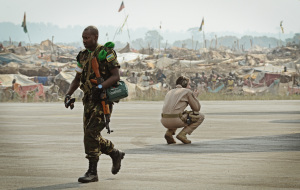Effectiveness of MINUSCA in Central African Republic Remains To Be Seen
 At this year’s United Nations General Assembly, newly inaugurated Indian Prime Minister Narendra Modi shifted the tone of the conversation by calling for reform of the United Nations. Although Modi was specifically discussing reform of the UN Security Council, changing other aspects of the UN’s operations may also have a significant impact on major world crises. One such crisis is that of the conflict in the Central African Republic. As the UN takes over the responsibility of containing violence in the CAR with the establishment of the United Nations Multidimensional Integrated Stabilization Mission in the Central African Republic (MINUSCA), a change in strategy may be valuable for the organization.
At this year’s United Nations General Assembly, newly inaugurated Indian Prime Minister Narendra Modi shifted the tone of the conversation by calling for reform of the United Nations. Although Modi was specifically discussing reform of the UN Security Council, changing other aspects of the UN’s operations may also have a significant impact on major world crises. One such crisis is that of the conflict in the Central African Republic. As the UN takes over the responsibility of containing violence in the CAR with the establishment of the United Nations Multidimensional Integrated Stabilization Mission in the Central African Republic (MINUSCA), a change in strategy may be valuable for the organization.
As it is one of the UN’s primary functions, peacekeeping has been an important part of the organization’s history. Often dismissed as ineffectual, the UN has an inconsistent track record on its peacekeeping operations. Many cite the failures to prevent further violence or ethnic cleansing in the UN’s missions in Rwanda (1993), Somalia (1994), and Srebrenica (1995) as examples of the ineffectiveness of the organization. However, the UN has often been praised for its peacekeeping activities in Lebanon after the 2006 conflict between Hezbollah and Israel as well as for the successful peacekeeping mission to Sierra Leone in 1999. In both cases, the UN peacekeeping forces were able to establish a substantial presence in each country, resulting in the development of withstanding peace. Achieving success in this aspect of peacekeeping may allow the UN forces to prevent further violence in the CAR.
An example of an extremely challenging mission in the same region is that of the United Nations Organization Stabilization Mission in the Democratic Republic of the Congo (MONUSCO). As the largest peacekeeping operation in the UN’s history, MONUSCO has been active in the DRC since 1999, helping to contain rebel militias after the Second Congo War and the various conflicts in the eastern Congo. While the DRC may now be on the road to peace, it is questionable if any success could be attributed to the MONUSCO forces. The peacekeeping operation has been plagued with scandal and misconduct since its early stages as individual peacekeepers have been charged in the past with sexual trafficking as well as selling weapons to militias.
Although the origins of the CAR conflict and its overall conditions have been much different than those of the Congo conflict, similar missteps have occurred in the process to establish peace in the CAR. The African-led International Support Mission to the Central African Republic (MISCA) was a peacekeeping mission established by the African Union in late 2013 to quell violence between the muslim Seleka rebels and the opposing anti-Balaka militias. MISCA forces have been accused of abusing their power as well as committing sexual violence against the local population. Although the African Union is now transferring the mission over to the UN, the serious mistrust towards peacekeepers that grew during MISCA may pose a challenge to the arriving MINUSCA forces.
In spite of the public opinion towards peacekeepers in the region, certain characteristics of the conflict indicate that mobilizing such a comprehensive peacekeeping operation like MINUSCA could successfully contain the violence in the CAR. The similarities between the 1999 intervention in Sierra Leone (UNAMSIL) and the events that have occurred in the CAR in the past year point towards the possible replication of what made UNAMSIL a success. Both cases involve a major insurgency against the government as well as the subsequent intervention of a European power (Britain in Sierra Leone and France in CAR). The goals of both of the peacekeeping missions are also similar, as MINUSCA is now tasked with enforcing the ceasefire between the Seleka and anti-Balaka, and integrating former rebels into civil society.
MINUSCA can be successful if it adopts some of the tactics used in UNAMSIL. During UNAMSIL, UN forces disarmed thousands of militants, built up Sierra Leone’s police force, cracked down on illicit trading, and worked with the British troops to train and equip the military. A critical part of the process was the inclusion of local communities in the peacekeeping process, a step that encompasses human rights education programs. By focusing heavily on disarming and reintegrating rebels as well as building a culture of respect for human rights, MINUSCA may be able to make progress in CAR. One of the missteps of past missions was the failure to properly engage assailants and defend civilians from attacks which exacerbated the existing mistrust of peacekeepers in the eyes of the public. MINUSCA can make use of its size and capabilities by actively engaging militias in combat.
People have called in the past for the UN to establish a standing army in order to increase its effectiveness at maintaining peace. This may be just as lofty a goal as truly reforming the Security Council, as Modi previously suggested. However, by avoiding the failures of past missions and capitalizing on the successes of others, new missions like MINUSCA could prove the efficacy of the UN.
